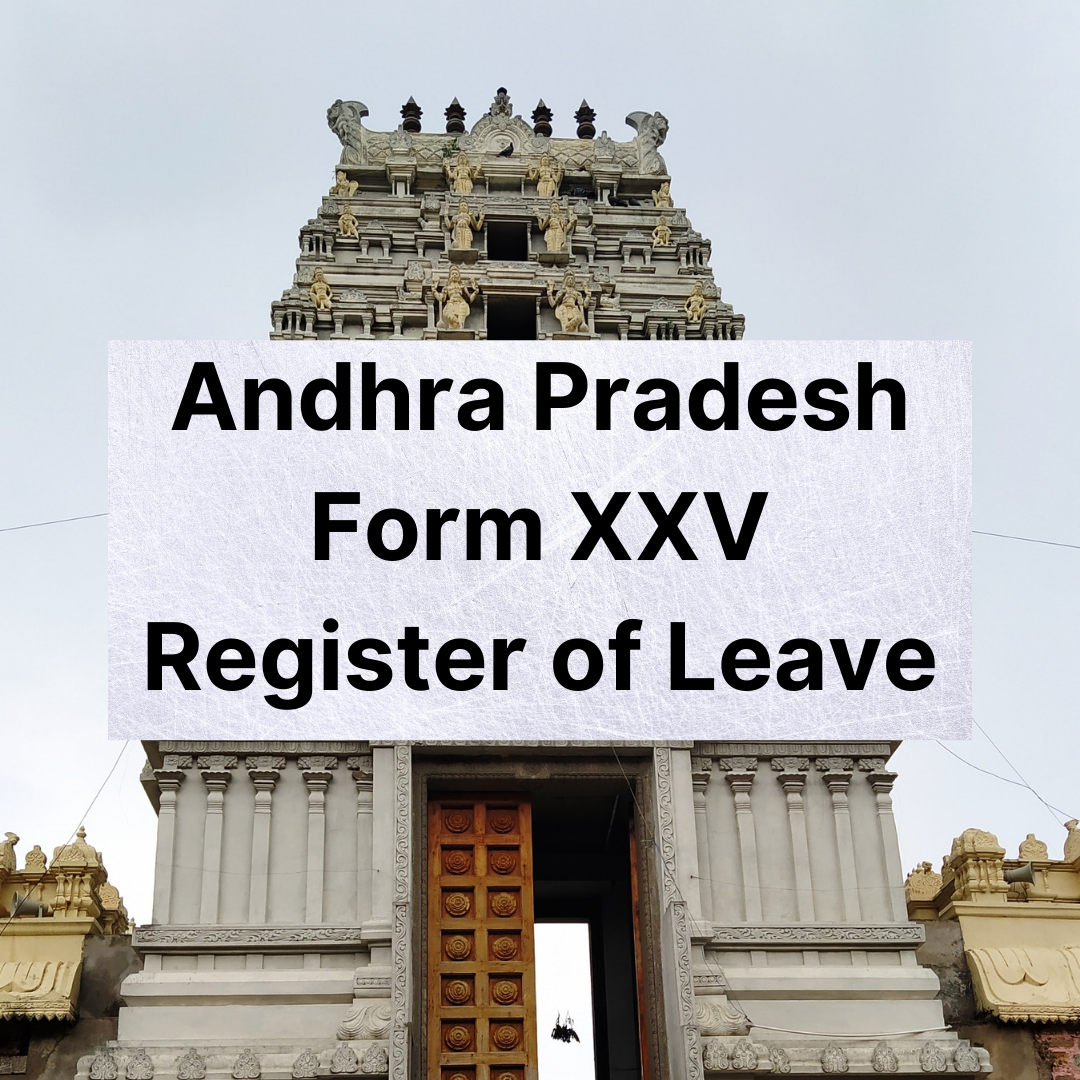Every worker or employee in a business or organization is eligible for paid leave. The number of days is determined as follows: one day for every twenty days of work accomplished by him in the case of an adult; one day for every fifteen days of work performed by him if the worker is a young person.
The register of leave with wages is a register maintained under the prescription of the Factories Act of 1948. Just like all the other forms included under the Act, this form, too, is drafted with an aim to safeguard the rights of the workers in the factory.
This article will take us through the leave register format and the various fields it exhibits. We shall be visiting briefly the Factories Act along with the following points:
- Factories Act, 1948: An Overview
- Applicability of Factories Act
- What is the Central Register of Leave with Wages?
- Central Register of Leave with Wages Format
- How can Deskera Help You?
- Key Takeaways
Factories Act, 1948: An Overview
The Factory Act of 1934 was enacted, which repealed all previous factory-related legislation. The law was written in response to the Royal Commission's labor recommendations. The experience of enforcing the Factory Act of 1934 has revealed numerous flaws and limitations that obstruct its efficient implementation. It has also resulted in seeking significant changes to the law to provide safety protections to a multitude of small industrial sites.
As a result, the Member Assembly passed the Factories Act 1948 on August 28, 1948, which made essential alterations to the Factory Act. On September 23, 1948, the Governor-General of India approved the law, which took effect on April 1, 1949. Eventually, the parliament adopted the Factories Act of 1948 on September 23, 1948.
Applicability of Factories Act
The Factories Act of 1948 applies to any factory that employs or has employed more than 10 people on any given day in the previous 12 months, and whose production process is powered by electricity. It is also applicable to all factories where 20 workers are employed or have been employed in the past year, when the manufacturing process is in operation, or when the manufacturing process is carried out without energy. Mining, hotels, railroad depots, restaurants, and canteens are not included.
What is the Central Register of Leave with Wages?
To understand the concept of the Central Register of leave with wages or the leave register format, we will be going through the complete attribute of ‘Annual leave with wages’. It will help us understand the various important elements it entails.
What is Annual leave with Wages?
Workers in a factory who have been employed for a period of 240 or more days shall be eligible to receive leave with wages in the subsequent calendar year. The rate at which the calculation is done in the following ways:
- In the case of an adult, there will be one leave against the 20 days of work done by them in the previous year
- In the case of a child, there will be one leave against the 15 days of work done by them in the previous year
This could be further elaborated as follows:
Explanation 1: As prescribed by this subsection:
- Based on agreement or contract, or as permitted by standing rules, the workers may avail of any days of layoff
- Female workers are eligible to receive maternity leaves up to 12 weeks
- For the purposes of computing the duration of 240 days or more, the leave earned in the year preceding the year in which the leave is taken shall be assumed to be days on which the worker worked in a factory, but he would not gain leave for these days.
Explanation 2: All holidays, whether falling during or at either end of the term of leave, are not included in the leave permissible under this subsection.
- A worker whose employment begins on a date other than January 1st is entitled to leave with wages at the amount set forth in clause
- Alternatively, if the worker has worked for two-thirds of the total number of days for the remaining part of the year, clause (ii) of sub-section (1) applies.
- If a worker quits, is dismissed, or dies, then their nominee shall receive the wages to which the worker was entitled before their departure. This would be applicable even if the worker had not worked for the complete term as mentioned in subsection (1) or subsection (2).
Also, this payment shall be made as follows:
- Where the worker is dismissed or quits employment prior to the end of the second working day from the date of discharge or quitting; and
- If the worker dies while in service before the expiry of two months from the date of death.
- Fractions of leave of half a day or more are treated as one full day's leave, while fractions of less than a half-day are removed for calculating leave under this section.
- If a worker does not take all of the leave permitted to him under sub-section (1) or (2) in a calendar year, any untaken leave is added to the leave allocated to him in the following calendar year
- Provided, however, that the total number of days of leave that may be carried over to the following year in the case of an adult or forty in the case of a child shall not exceed thirty in the case of an adult or forty in the case of a child.
- Furthermore, a worker who has filed for paid leave but has not been granted such leave in line with any plan established in sub-sections (8) and (9) 27[or in violation of subsection (10)] shall be allowed to carry 2 forward the 28[leave refused] without limitation.
- A worker must apply to the manager in writing at least 15 days before the date on which they wish to take the leave during the calendar year
The application, however, must be made at least theory days before the date the worker wishes to begin his leave when they are employed in public utility service as indicated in section 2 clause (n) of the Industrial Dispute Act of 1947. Furthermore, the condition applies that the worker cannot apply for leave more than three times in a year.
- If a worker wishes to take leave due to an illness or an ailment, they shall be granted the leave in case they do not make the application in the time indicated in subsection 6. Wages in such cases will be paid within 15 days. In the case of public utility services, it should be thirty days from the date of application of leave.
- The manager or the occupier of the factory may bring forward a scheme with the Chief Inspector to ensure continuity of work. The scheme will ensure the regulation of the grant of leave under section 3, Industrial Disputes Act of 1947 or a similar working authority.
- A scheme filed under subsection (8) must be exhibited in a visible and convenient location in the factory and must be in effect for a period of twelve months from the day it is filed. It may then be renewed by the manager in consultation with the Works Committee or a similar committee for another twelve-month period with or without modification. Or, in the event of sub-section (8), in agreement with the workers' representatives, a notice of renewal shall be provided to the Chief Inspector before it is renewed.
- A request for leave that does not violate the provisions of sub-section (6) will not be denied unless it is in conformity with the system in effect at the time under sub-section (8) and (9).
- If the occupier of the factory terminates the employment of a worker who is entitled to leave under subsection (1) or (2) before he has taken the entitled leave, the occupier of the factory must pay him the amount due under section 80 for the leave not taken. Payment must be provided by the end of the second working day following the termination, and on or before the next payday in the case of a worker who quits his job.
- A worker's unpaid leave will not be taken into account for calculating the length of any notice required before discharge or dismissal.
Central Register of Leave with Wages Format
The format of the form for the register of leave with wages is as shown in the following image. It must be managed by the manager in the prescribed format. This register of leave with wages must be kept preserved for up to three years since the last entry made into it. Whenever an inspector demands to see it, the manager must produce and present it for an inspection.
We shall visit all the fields mentioned in the form here:

At the topmost part of the form, we find Part I and Part II which are for adults and children respectively. Following this, we must enter the name of the factory, the name of the worker, the department, and the worker’s father’s name.
Thereafter, we come across the following fields:
- Serial number
- Serial number of the adult or the child in the register of workers
- Date of joining or entry in the employment or service
- Accidents and sickness
- Authorized leave
- Lockout or legal strike
- Mention if there is involuntary unemployment
- Include any other applicable reason in this column
- Enter the date from which the leave comes into effect
- Inform if there is no leave desired in the next one year
- Mention the date from which the worker is permitted to be on leave
- Enter the wages for leave paid in
- Enter the date of discharge of the worker
- Mention the date and amount of the payment made against the due leave
- Add any other relevant remarks if applicable.
How can Deskera Help You?
Deskera People provides all the employee's essential information at a glance with the employee dashboard. With sorting options embedded in each column of the grid, it is easier to get the information you want.
In addition to a powerful HRMS, Deskera offers integrated Accounting, CRM & HR Software for driving business growth.
To learn more about Deskera and how it works, take a look at this quick demo:
Key Takeaways
Let’s take a look at the following takeaways from the article:
- Every worker or employee in a business or organization is eligible for paid leave.
- The number of days is determined as follows: one day for every twenty days of work accomplished by him in the case of an adult; one day for every fifteen days of work performed by him if the worker is a young person.
- The register of leave with wages is a register maintained under the prescription of the Factories Act of 1948.
- the Member Assembly passed the Factories Act 1948 on August 28, 1948, which made essential alterations to the Factory Act. On September 23, 1948, the Governor-General of India approved the law, which took effect on April 1, 1949. Parliament adopted the Factories Act of 1948 on September 23, 1948.
- The Factories Act of 1948 applies to any factory that employs or has employed more than 10 people on any given day in the previous 12 months, and whose production process is powered by electricity.
- It also applies to all factories where 20 workers are employed or have been employed in the last 12 months, when the manufacturing process is in operation, or when the manufacturing process is carried out without the use of energy.
- In the case of an adult, there will be one leave against the 20 days of work done by them in the previous year
- In the case of a child, there will be one leave against the 15 days of work done by them in the previous year
- This register of leave with wages must be kept preserved for up to three years since the last entry made into it. Whenever an inspector demands to see it, the manager must produce and present it for an inspection.
- The central register for leave with wages is a form that comprises information such as the date of joining, authorized leave, lockout or legal strikes, any involuntary unemployment, and date from which the leave comes into effect. It also includes information like the wages for paid leave, date of discharge of the worker, date and amount paid for the leave, and any other relevant remarks.
Related Articles













